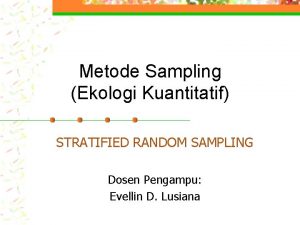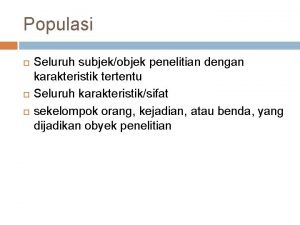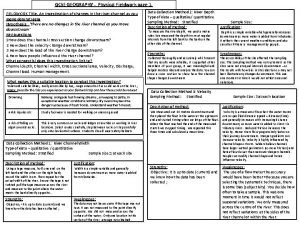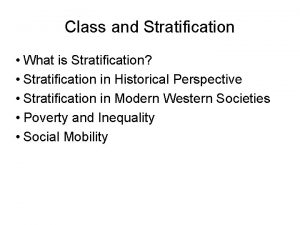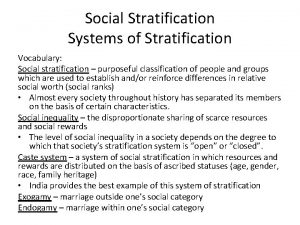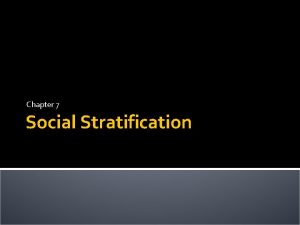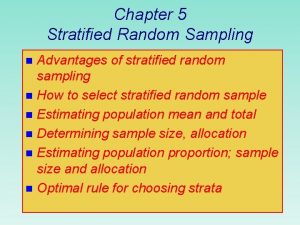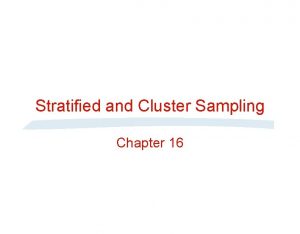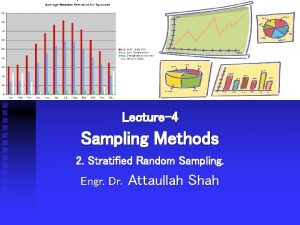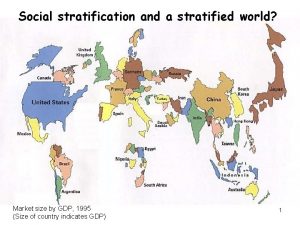STRATIFIED SAMPLING STRATIFIED SAMPLING 1 Stratification The elements

















- Slides: 17

STRATIFIED SAMPLING

STRATIFIED SAMPLING 1. Stratification: The elements in the population are divided into layers/groups/ strata based on their values on one/several auxiliary variables. The strata must be nonoverlapping and together constitute the whole population. 2. Sampling within strata: Samples are selected independently from each stratum. Different selection methods can be used in different strata.

Ex. Stratification of individuals by age group Stratum Age group 1 17 or younger 2 18 -24 3 25 -34 4 35 -44 5 45 -54 6 55 -64 7 65 or older

Ex. Regional stratification Stratum 1: Northern Sweden Stratum 2: Mid. Sweden Stratum 3: Southern Sweden

Ex. Stratification of individuals by age group and region Stratum Age group Region 1 17 or younger Northern 2 17 or younger Mid 3 17 or younger Southern 4 18 -24 Northern 5 18 -24 Mid 6 18 -24 Southern etc.

WHY STRATIFY? • Gain in precision. If the strata are more homogenous with respect to the study variable(s) than the population as a whole, the precision of the estimates will improve. • Strata = domains of study. Precision requirements of estimates for certain subpopulations/domains can be assured by using domains as strata.

WHY STRATIFY? , cont’d • Practical reasons. For instance nonresponse rates, method of measurement and the quality of auxiliary information may differ between subpopulations, and can be efficiently handled by stratification. • Administrative reasons. The survey organization may be divided into geographical districts that makes it natural to let each district be a stratum.

ESTIMATION Assume a population divided into H strata of sizes. Independently, a sample of size nh is selected from each stratum. = y-value for element j in stratum h = population total for stratum h = sample mean for stratum h

ESTIMATION OF A TOTAL Assume: SRS within all strata. 9

ESTIMATION OF A TOTAL Assume: SRS within all strata. In general: What is the variance of this estimator? 10

VARIANCE OF THE ESTIMATOR OF A TOTAL Principle: Add the variances of the estimators for each stratum. A legitimate approach since samples are selected independently from each stratum. Remember: if X, Y are independent random variables. 11

VARIANCE OF THE ESTIMATOR OF A TOTAL, cont’d Result: One term per stratum Finite population correction (one per stratum!) where 12

ESTIMATION OF THE VARIANCE OF THE ESTIMATOR OF A TOTAL Principle: Estimate what’s unknown in the variance formula. where 13

ESTIMATORS FOR A MEAN Note: Start from the estimators for a total!

ESTIMATORS FOR A MEAN, cont’d Note: Start from the estimators for a total!

ESTIMATORS FOR A PROPORTION Note: Like the estimators for a mean, only with y a 0/1 -variable!

IMPORTANT DESIGN CHOICES IN STRATIFIED SAMPLING • Stratification variable(s) • Number of strata • Sample size in each stratum (allocation) • Sampling design in each stratum • Estimator for each stratum 17
 What is stratified sampling
What is stratified sampling Cluster sampling vs stratified sampling
Cluster sampling vs stratified sampling Objectives of sampling
Objectives of sampling Undercoverage bias
Undercoverage bias Stratified random sampling adalah
Stratified random sampling adalah Demand characteristics
Demand characteristics Stratified sampling formula
Stratified sampling formula Application of statistics
Application of statistics Rumus wibisono populasi tidak diketahui
Rumus wibisono populasi tidak diketahui Stratified sampling adalah
Stratified sampling adalah Sample frame
Sample frame Stratified sampling gcse
Stratified sampling gcse Non probability sampling
Non probability sampling Stratified sampling physical geography
Stratified sampling physical geography Populasi adalah wilayah generalisasi
Populasi adalah wilayah generalisasi Disproportionate stratified random sampling contoh
Disproportionate stratified random sampling contoh What is a stratified sampling
What is a stratified sampling Probability sampling vs non probability sampling
Probability sampling vs non probability sampling




